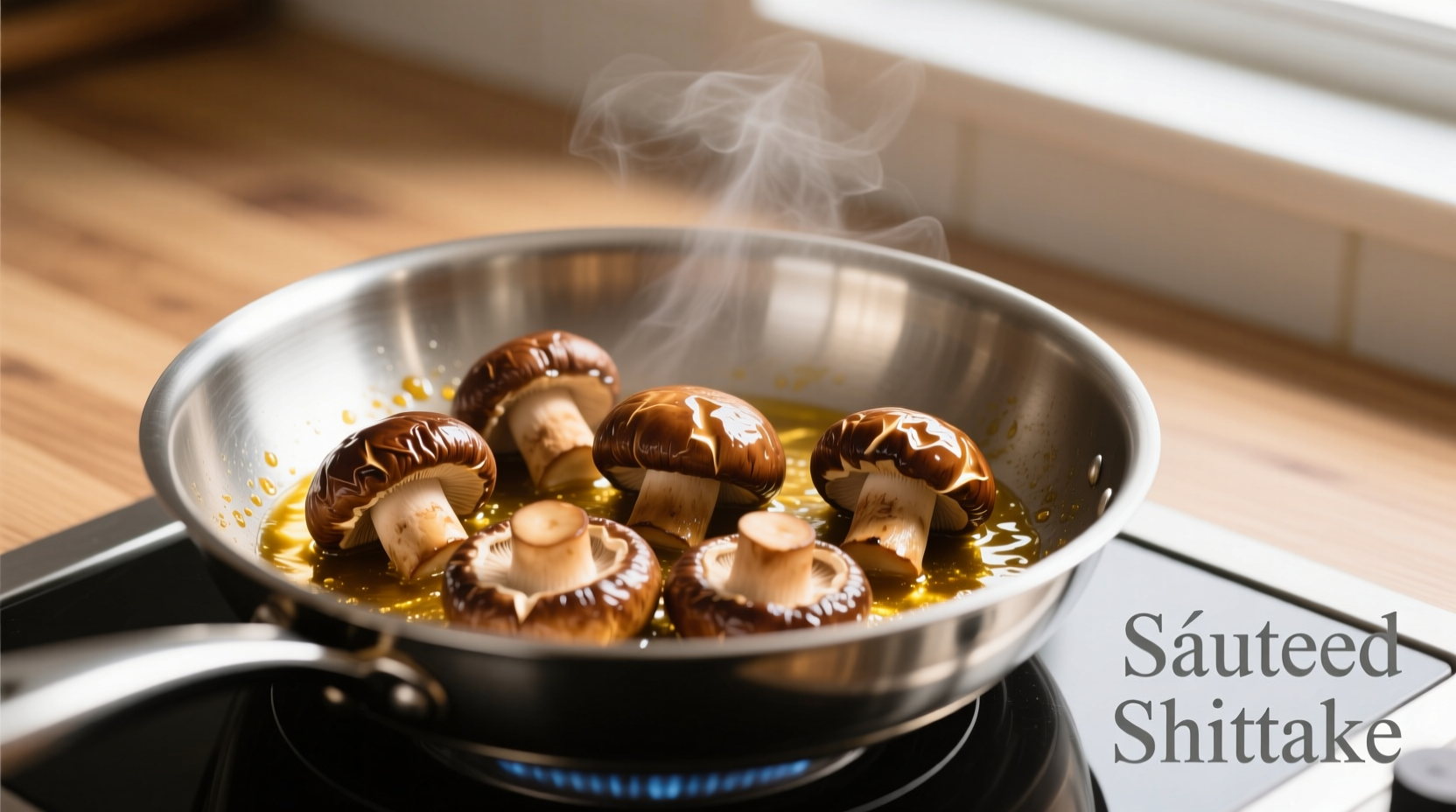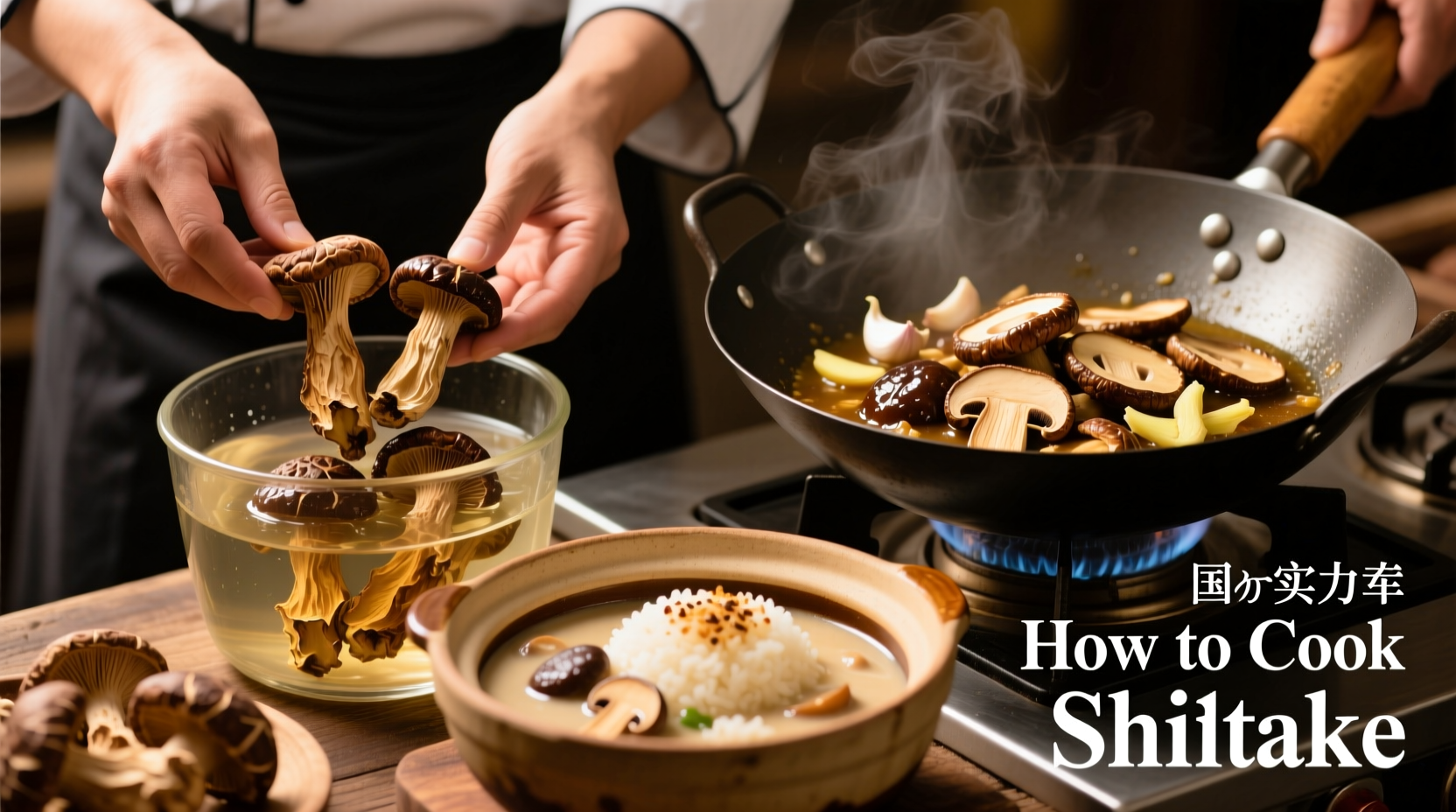Master shiitake cooking with these essential facts: Remove tough stems before cooking, sauté slices for 6-8 minutes over medium-high heat until golden brown, and never wash mushrooms under running water—wipe clean with a damp cloth instead. Properly cooked shiitake delivers an umami-rich flavor that elevates dishes from simple stir-fries to sophisticated sauces.
Discover the complete guide to unlocking shiitake mushrooms' deep, savory potential in your kitchen. Whether you're a beginner cook or an experienced chef, these science-backed techniques transform ordinary shiitake into extraordinary culinary elements. You'll learn professional preparation methods, optimal cooking times, and flavor pairing secrets that home cooks rarely know.
Understanding Shiitake's Unique Characteristics
Shiitake mushrooms (Lentinula edodes) offer a distinctive umami flavor profile that sets them apart from common button mushrooms. Their complex taste comes from naturally occurring glutamates and guanylate compounds that intensify when properly cooked. According to the USDA FoodData Central, shiitake contain nearly double the protein of white mushrooms and provide significant amounts of selenium, copper, and B vitamins.
Fresh shiitake have a firm cap with a slightly curled edge when young, becoming flatter as they mature. The stems are typically too tough for direct consumption but can be used to make flavorful stocks. Dried shiitake concentrate their umami compounds, making them valuable for creating rich broths—a technique documented in Japanese culinary traditions for centuries.
Preparation Fundamentals: Setting the Stage for Success
Proper preparation directly impacts your final dish's quality. Start by selecting mushrooms with intact caps and no dark spots or slimy texture. The FDA recommends storing fresh shiitake in paper bags in your refrigerator's crisper drawer for optimal freshness.
Cleaning technique matters: Contrary to popular belief, mushrooms don't absorb excessive water when cleaned properly. However, shiitake's delicate texture makes the wipe method preferable. Use a slightly damp cloth or soft brush to remove dirt, working from the cap's center outward. Never soak shiitake—this waterlogging dilutes their flavor compounds.
Stem management: While the caps are culinary stars, the stems shouldn't be discarded. Reserve them for stocks or finely chop for stir-fries. When preparing for sautéing or roasting, slice caps uniformly at ¼-inch thickness for even cooking. Thinner slices work best for quick cooking methods like stir-frying, while thicker cuts suit roasting.
| Cooking Method | Temperature | Time | Best For |
|---|---|---|---|
| Sautéing | Medium-high (375°F) | 6-8 minutes | Stir-fries, pasta dishes |
| Roasting | 425°F | 15-20 minutes | Side dishes, grain bowls |
| Grilling | Medium (350°F) | 8-10 minutes | Summer dishes, kebabs |
| Drying | 150°F | 6-8 hours | Stocks, sauces |
Mastering Shiitake Cooking Techniques
Each cooking method extracts different flavor compounds from shiitake. Understanding these differences helps you select the right technique for your dish.
Sautéing: The Flavor Maximizing Method
This technique develops the deepest flavor through the Maillard reaction. Heat a combination of oil and butter (1:1 ratio) in a stainless steel or cast iron skillet until shimmering but not smoking. Add mushrooms in a single layer without crowding—this critical step prevents steaming. Wait 3-4 minutes before stirring to allow proper browning.
"The key to perfect sautéed shiitake is patience," explains Antonio Rodriguez, culinary expert with Michelin-starred kitchen experience. "Let them develop that golden crust before moving them. This caramelization creates complex flavor compounds you can't achieve otherwise."
After the first flip, add aromatics like minced garlic or shallots. Finish with a splash of soy sauce or tamari during the last minute of cooking—this reacts with the mushrooms' natural sugars to create additional umami compounds.
Roasting: Concentrating Flavor
Roasting intensifies shiitake's natural sugars through slow caramelization. Toss mushroom slices with olive oil, salt, and pepper, then spread on a parchment-lined baking sheet. For maximum flavor development, roast at 425°F for 15-20 minutes, flipping halfway through.
The American Culinary Federation recommends adding a small amount of acid (like balsamic vinegar) during the last 5 minutes of roasting. This reacts with the concentrated sugars to create a glossy, flavorful glaze that enhances the mushrooms' natural umami.
Dried Shiitake Applications
Dried shiitake contain lenthionine, a sulfur compound that develops during drying and creates intense umami. To rehydrate, soak in warm water for 20-30 minutes. Save the soaking liquid—it's liquid umami gold perfect for soups and sauces.
For the most flavorful stock, simmer dried shiitake with kombu (kelp) for 20 minutes. The Mushroom Council notes this combination creates a synergistic umami effect greater than either ingredient alone. Strain and use immediately or freeze for future use.
Avoiding Common Shiitake Mistakes
Even experienced cooks make these preventable errors:
- Overcrowding the pan: This lowers the temperature and causes steaming instead of browning. Cook in batches if necessary.
- Adding salt too early: Salt draws out moisture, preventing proper browning. Wait until mushrooms have developed some color.
- Under-seasoning: Shiitake's robust flavor can handle bold seasoning. Don't be shy with aromatics and acids.
- Discarding stems: While too tough for direct consumption, stems add incredible depth to stocks and sauces.
Flavor Pairing Strategies
Shiitake's umami profile pairs beautifully with specific ingredients that enhance their natural compounds:
Asian-inspired combinations: Pair with ginger, garlic, soy sauce, and sesame oil. The amino acids in soy interact with shiitake's guanylate for amplified umami.
Western applications: Combine with thyme, rosemary, and white wine. The alcohol in wine helps extract fat-soluble flavor compounds from the mushrooms.
Unexpected pairings: Try shiitake with dark chocolate in mole sauces, or with miso in vegetarian "bacon" applications. These combinations leverage the Maillard reaction products that both ingredients share.

Advanced Shiitake Applications
Elevate your cooking with these professional techniques:
Shiitake dashi: Simmer dried shiitake in water at 160°F for 20 minutes (not boiling, which creates bitterness). This delicate broth forms the foundation of many Japanese dishes.
Mushroom powder: Dehydrate cooked shiitake, then grind to a fine powder. This concentrated umami booster enhances sauces, rubs, and even egg dishes.
Infused oils: Slowly heat shiitake in neutral oil at 180°F for 30 minutes. Strain and use for finishing dishes—the oil captures volatile flavor compounds that enhance the mushrooms' aroma.
Remember that cooking time varies based on your stove's heat output and the specific mushroom's moisture content. The perfect shiitake should be tender but still offer slight resistance when bitten—a texture chefs call "al dente" for mushrooms.
Frequently Asked Questions
Can you eat shiitake mushroom stems?
While shiitake caps are tender and delicious, the stems are typically too fibrous for direct consumption in most dishes. However, they're excellent for making stocks and broths. Simply simmer stems in water for 20-30 minutes to extract their flavor, then strain before using the liquid in soups or sauces.
How long should you cook shiitake mushrooms?
For sautéing, cook shiitake for 6-8 minutes over medium-high heat until golden brown and tender. Roasting takes 15-20 minutes at 425°F. The mushrooms should be tender but still offer slight resistance when pierced with a fork—avoid overcooking which makes them rubbery.
What's the best oil for cooking shiitake mushrooms?
A combination of neutral oil (like grapeseed or avocado) and butter works best. The oil has a higher smoke point for proper browning, while butter adds flavor compounds that complement the mushrooms' umami. For Asian dishes, toasted sesame oil added at the end enhances the flavor profile.
Why do my shiitake mushrooms turn out soggy?
Soggy shiitake usually results from overcrowding the pan or adding salt too early. Both cause the mushrooms to release moisture faster than it can evaporate. Cook in a single layer without stirring for the first 3-4 minutes, and add salt only after some browning has occurred to achieve perfectly seared mushrooms.











 浙公网安备
33010002000092号
浙公网安备
33010002000092号 浙B2-20120091-4
浙B2-20120091-4